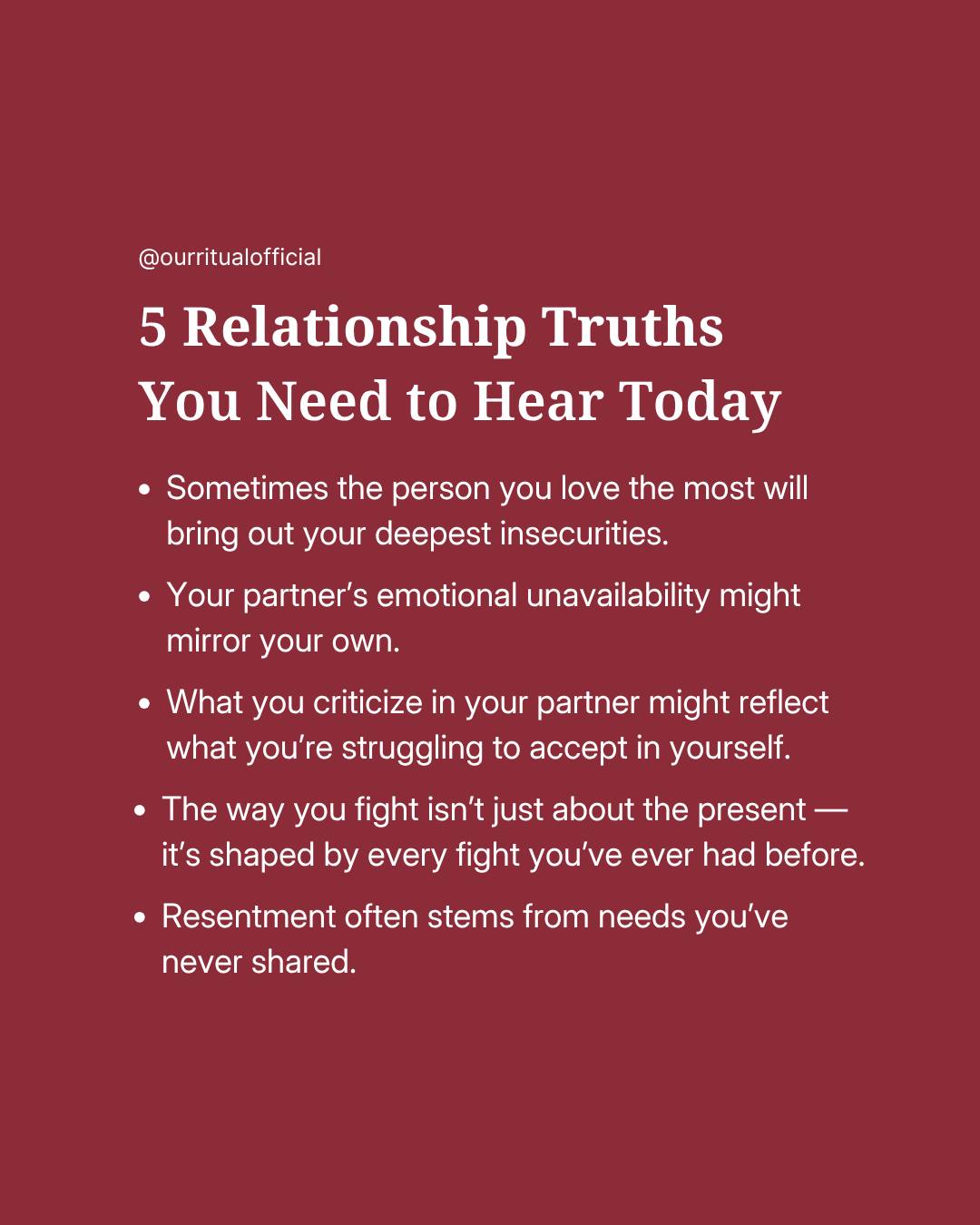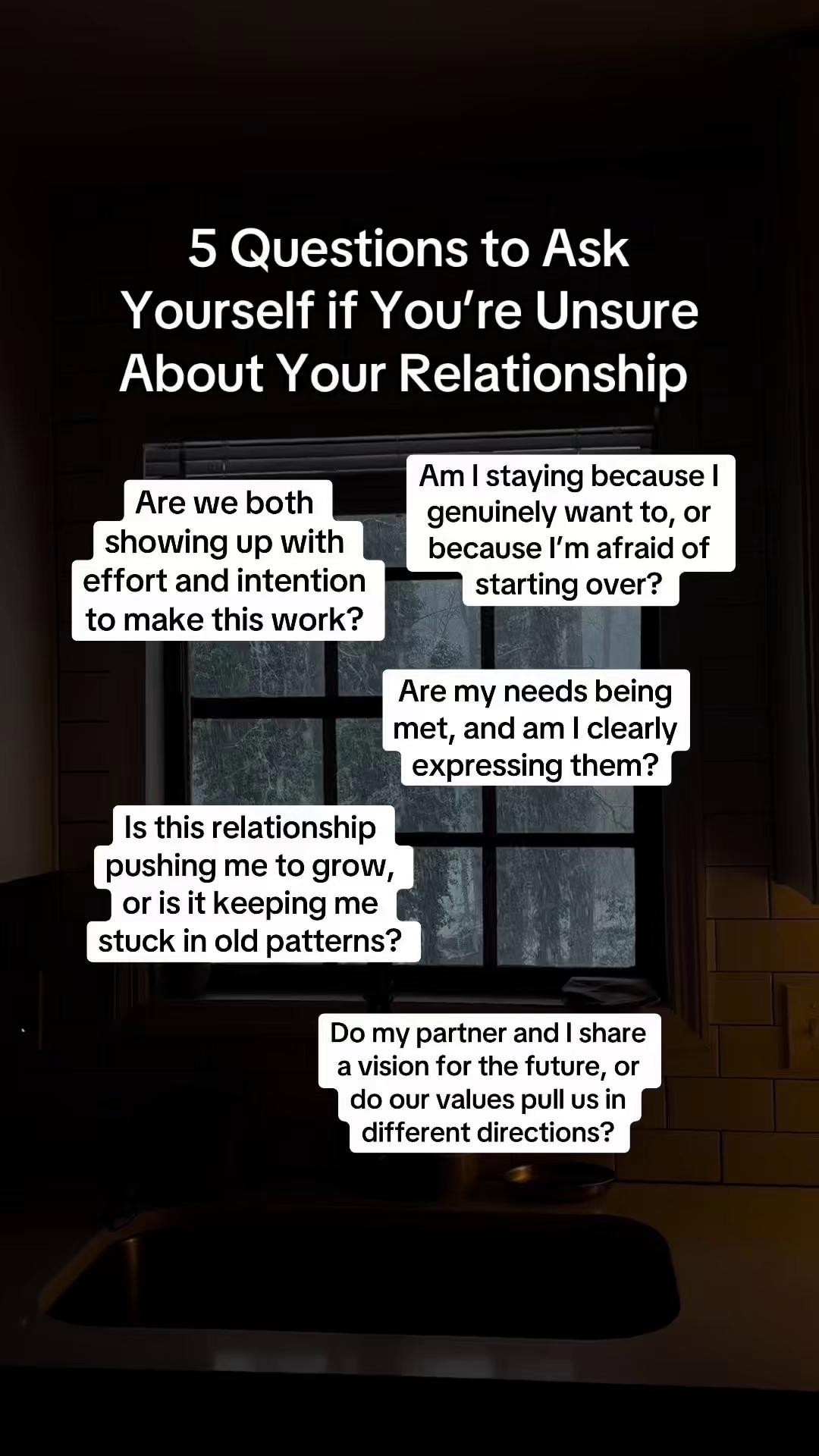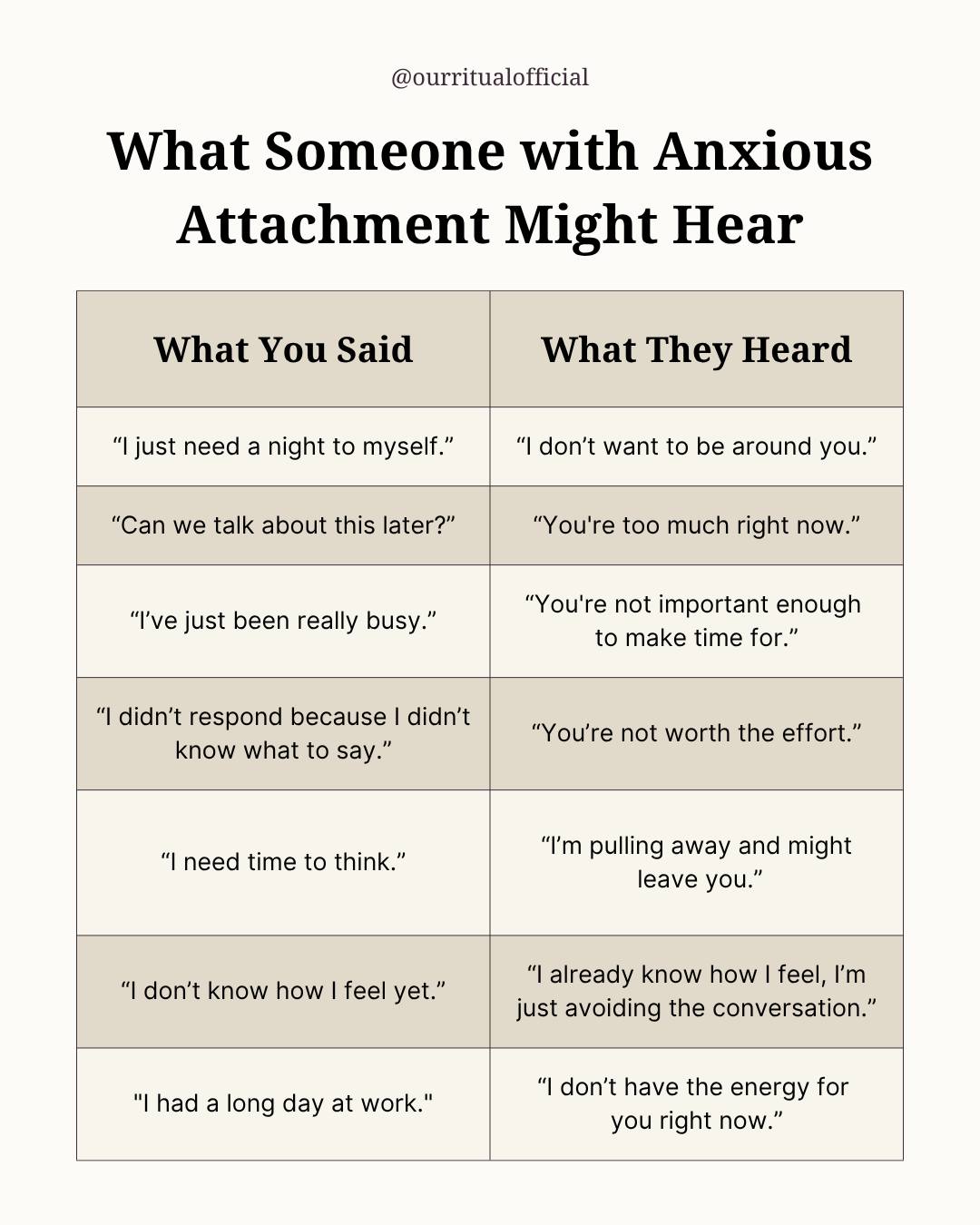Relationship Health Checklist for Couples
Just like your body needs regular check-ups to stay healthy, your relationship needs a little care and attention, too. If you're hoping to feel more connected, supported, and secure with your partner, it might be time for a relationship check-in. These are some of the most important areas to keep an eye on:
- Communication: Do you both feel heard, understood, and able to speak openly?
- Trust: Is it built through small, consistent actions - especially in challenging moments?
- Conflict resolution: Can you handle disagreements together without blame or escalation?
- Intimacy: Are you maintaining both emotional closeness and physical connection?
- Shared goals: Are your values aligned, and are you building toward a future you both want?
Small, consistent actions can make a big difference. Try weekly check-ins, express gratitude often, and make space for quality time. Even something as simple as addressing conflict calmly can strengthen your connection. Track your progress over time and celebrate the little wins, because growth happens with steady effort, not perfection.
If you're unsure where to begin, a relationship self-assessment can help you understand which areas are thriving and which ones need more care.
Relationship Health Self-Assessment
A relationship health self-assessment helps pinpoint the strengths and areas that could use some attention in your partnership. By focusing on key aspects that shape a healthy relationship, this evaluation provides a clearer view of where you stand and where you can grow together.
Key Areas to Evaluate
The most effective relationship assessments focus on five core areas, backed by years of research. These elements paint a well-rounded picture of your connection and its overall health.
- Communication and Emotional Connection: How well do you express your needs, actively listen, and maintain emotional closeness? Ask yourself: Do you feel heard, understood, and supported emotionally by your partner?
- Trust and Commitment: This area measures the depth of security and reliability in your relationship. It’s about being able to trust your partner with your vulnerabilities, keeping promises, and staying faithful. Trust creates a safe space where both partners can be their authentic selves without fear of judgment or betrayal.
- Conflict Resolution and Problem-Solving: How do you and your partner handle disagreements? Healthy couples approach conflict constructively, openly discussing issues, finding compromises, and repairing any disconnection that may arise after disagreements.
- Intimacy and Physical Connection: This includes emotional closeness, physical affection, and your sexual relationship. It’s about whether your interactions foster a meaningful bond beyond the daily grind.
- Shared Meaning and Goals: Are you building a life together that feels purposeful? This involves shared values, future plans, and a sense of working toward common goals as a team.
Additionally, understanding your attachment style - whether secure, anxious, avoidant, or disorganized - can shed light on how you approach intimacy, express emotions, and navigate conflict.
How to Use the Assessment
Once you’re familiar with these key areas, here’s how to effectively assess and strengthen your relationship:
Start by completing the assessment individually. Each partner should take time to honestly rate the relationship in all five areas without discussing answers upfront. Reflect on your satisfaction in each category, noting both strengths and challenges.
Set aside time for a focused conversation to compare your results. Begin by celebrating what’s working well. Highlighting the positives first creates a strong foundation for growth.
From there, identify shared areas that need improvement. Look for patterns in your responses and agree on which challenges to address first. If your perspectives differ, use this as an opportunity to better understand each other’s needs.
Create specific, actionable steps to tackle these areas. For example, instead of saying, “We need to communicate better,” choose something small and doable, like setting a rule to pause before responding during tough conversations, practicing active listening by repeating back what your partner said to ensure understanding, or agreeing to bring up concerns during a weekly check-in rather than in the heat of the moment. Small habits like these can make your communication feel safer and more constructive - and help turn vague intentions into real change.
Regular check-ins - whether monthly or quarterly - can help you stay connected and address minor issues before they escalate. Over time, as you grow and evolve, your assessment results may shift, offering new opportunities to strengthen your bond.
Communication Exercises and Tools
Good communication is the backbone of healthy relationships - Many people wish they were better at discussing difficult topics. Communication is a skill you can improve with the right tools and consistent practice. These exercises aim to help couples talk and listen more effectively while also building emotional and physical intimacy.
Weekly Check-Ins
Weekly check-ins create a designated space for meaningful connection, away from the hustle of daily life. These structured conversations can stop small problems from becoming big ones and help couples stay on the same page.
Pick a consistent time each week when you're both relaxed and available. Many couples find Sunday evenings or Saturday mornings work well. Plan for about 30 minutes, and set a reminder to make it a habit.
Start by setting a few ground rules: take turns speaking, use "I feel" statements, and avoid criticism or blame. Begin the check-in on a positive note - share what went well during the week, moments you appreciated, or times you felt close to each other. This sets a supportive tone before moving on to any challenges.
Prepare a few questions to guide the conversation. You might ask about feelings, concerns, or highlights from the past week. Discuss upcoming plans or decisions that need attention. Wrap up by expressing gratitude or summarizing takeaways from the discussion.
Keep the HALT principle in mind - if one of you is Hungry, Angry, Lonely, or Tired, reschedule the check-in for a better time. While flexibility is important, try to reschedule promptly to maintain consistency.
These check-ins naturally lead into practicing active listening.
Active Listening Techniques
Active listening takes things a step further by helping you truly understand your partner. It’s about focusing entirely on their words, emotions, and perspective, rather than planning your response. This approach can ease tension and make your partner feel genuinely heard.
Start by eliminating distractions - put away your phone, make eye contact, and give your partner your full attention. Listen without interrupting, even if you disagree with what they’re saying.
Paraphrasing is a great way to show you’re engaged. Repeat what your partner said in your own words to confirm you’ve understood them. For example, “So you felt overwhelmed when I didn’t help with dinner prep. Is that right?” This gives them a chance to clarify if needed.
Ask clarifying questions when something isn’t clear. Open-ended questions like, “Can you tell me more about how you’re feeling?” or “What would help you most right now?” show that you’re invested in their perspective.
Validate their emotions by acknowledging how they feel, not just what they’re saying. Phrases like, “I can see this really matters to you” or “It sounds like you’re feeling frustrated” can make your partner feel supported and understood.
Resist the urge to get defensive or jump straight into problem-solving. Sometimes, your partner just needs to feel heard before they’re ready to tackle solutions together.
In addition to building skills through direct conversations, many couples find it helpful to use digital tools that offer structured support between check-ins.
Using Digital Tools
Technology can be a great ally in improving communication, offering tools that help couples stay consistent and guided in their efforts. These platforms provide structure and expert-backed insights to complement your relationship work.
For instance, OurRitual offers science-based exercises and digital tools to help couples strengthen their communication skills. The platform allows you to practice at your own pace while having access to professional advice when needed.
Apps with guided prompts or reminders can also be useful for starting meaningful conversations or exploring new aspects of your relationship. Additionally, shared calendars or planning apps can help coordinate schedules, ensuring you both prioritize time for meaningful discussions. When communication becomes a regular part of your routine, it’s easier to see progress.
The key is to choose tools that simplify rather than complicate your efforts. Start small - pick one or two features that address your current needs, and expand as you find what works best for your relationship.
Building Intimacy and Connection
Strengthening intimacy in a relationship doesn’t rely on grand gestures or rare, special occasions - it’s about the little things you do every day. Studies show that couples who prioritize habits like expressing gratitude, sharing physical affection, and spending quality time together tend to build stronger emotional bonds than those who focus only on big, sporadic moments. Making these connections part of your daily life requires intentional effort from both partners.
Whether you’re juggling packed schedules, managing a long-distance relationship, or navigating unique challenges, there are practical ways to deepen your bond. A great place to start is by practicing daily gratitude.
Daily Gratitude Practice
Taking a moment each day to appreciate your partner can have a profound impact on your relationship. When you consistently acknowledge and express what you value about each other, you create a positive cycle of trust and affection.
Try sharing one specific thing you appreciate about your partner every day. Instead of a vague “thanks for everything,” go for something more personal, like, “I really loved how you helped me relax when I was stressed about work today.”
You can express gratitude in different ways: say it over your morning coffee, send a quick text during the day, or even a simple smile with a whispered “thank you”. Some couples enjoy leaving sticky notes for each other, while others make it part of their nightly routine. Find what feels natural and sustainable for your relationship.
Nonverbal gestures can be just as powerful. A hug, holding hands, or a simple touch can convey appreciation without words and help maintain a sense of physical connection.
Also, remember that gratitude works both ways. When your partner expresses appreciation, accept it with grace rather than brushing it off. This creates a safe, open space for both of you to feel seen and valued.
Scheduled Quality Time
Quality time doesn’t just happen - it needs to be planned and protected. Couples who prioritize regular, intentional time together often report feeling more connected and fulfilled. Treat this time as seriously as any work meeting or important appointment.
Date nights are a tried-and-true way to nurture your bond. Whether it’s weekly, bi-weekly, or monthly, find a rhythm that works for both of you.
During your time together, create tech-free zones. Put your phones away, turn off the TV, and focus solely on each other. This undivided attention allows for meaningful conversations and a deeper connection, free from daily distractions.
Quality time doesn’t have to mean elaborate plans. Morning coffee, a weekend walk, or cooking dinner side by side can be just as impactful. The key is consistency and intention.
Shared activities can also bring you closer while creating lasting memories. Consider taking a class together, tackling a home project, or exploring a new hobby that excites you both.
Activities Based on Your Needs
Every relationship is unique, and what strengthens one couple’s bond might not work for another. Tailoring your activities to your specific situation can make all the difference.
- For busy parents: Carve out smaller, intentional moments of connection—like a quick morning check-in over coffee, a quiet chat before bed, or a short walk together after the kids are asleep.
- For long-distance couples: Try virtual date nights, shared playlists, or sending voice memos throughout the day to stay emotionally close despite the distance.
- For couples navigating stress or burnout: Schedule a no-phones dinner once a week, take turns planning a low-effort “comfort night” with your favorite food and show, or simply practice 5 minutes of mindful breathing together.
- For couples craving more fun or adventure: Try something new together, like a cooking class, an escape room, or even just switching up your walking route and exploring a new neighborhood.
The key is to experiment and discover what helps you feel more connected. The best activities are the ones that feel doable and meaningful to both of you.
Conflict Resolution Strategies
Disagreements are bound to happen in any relationship, but how you handle them can either strengthen your connection or create distance. The aim isn’t to avoid conflict altogether - it’s to approach it in a way that fosters understanding and brings you closer. By honing effective conflict resolution skills, couples can turn challenges into opportunities for growth and deeper connection.
Let’s start by understanding what sparks these disagreements in the first place.
Identifying Triggers and Patterns
To resolve conflicts effectively, you first need to understand what causes them. Many disputes follow recurring patterns, and recognizing these cycles is the key to breaking them.
It starts with self-awareness. Triggers often stem from past experiences, prompting automatic reactions.
Take time to reflect on your typical reactions during disagreements. Do you lash out, shut down, freeze, or try to appease your partner? Identifying your default response can help you approach future conflicts with more intention.
Keeping track of conflicts and your reactions can uncover patterns, such as heightened stress during financial discussions or feeling upset when you think you’re being ignored. Sharing these insights with your partner, free from blame, can encourage empathy and mutual understanding.
Healthy Communication During Disagreements
Using "I" statements can shift the focus from blame to your own feelings. For example, saying, "I feel hurt when I'm interrupted" is far more constructive than, "You never listen." Many relationship experts recommend starting with an expression of care, such as, "I value our relationship", before addressing a specific behavior and requesting a change.
When your partner speaks, give them your full attention. Avoid interrupting and reflect back what you’ve heard to ensure understanding. If emotions start to escalate, use a prearranged code word like "time out" and take a 20-minute break to calm your nervous system.
Stay focused on the issue at hand, and avoid bringing up past grievances. This helps prevent the conflict from spiraling out of control.
Problem-Solving Steps
Once you’ve established respectful communication, you can move into problem-solving. Here’s how:
- Acknowledge and Pause: Recognize that conflict is a normal part of relationships. If emotions run high, take a 20-minute break to cool off.
- Listen to Understand: Allow each person to share their perspective without interruptions. Focus on building your relationship rather than "winning" the argument.
- Identify Underlying Needs: Look beyond surface-level disagreements to uncover deeper feelings. For example, a fight about chores might really be about feeling unappreciated.
- Brainstorm Solutions Together: Work as a team to come up with options that address both of your needs. Avoid rushing to a compromise that leaves either of you dissatisfied.
- Agree on a Plan: Decide on clear steps, including who will do what and by when. Also, set a time to check in on your progress.
- Follow Up and Adjust: Revisit the plan to see how it’s working, and be willing to make changes if necessary.
Conclusion: Building a Stronger Relationship Together
Creating a healthy relationship isn’t about grand gestures or achieving perfection - it’s about the small, consistent choices we make every day.
The ideas shared earlier highlight how your daily habits can strengthen your connection. Simple actions like practicing active listening during weekly check-ins, showing gratitude every day, or approaching disagreements with curiosity instead of defensiveness can make a big difference over time.
Start small by focusing on one or two areas that resonate with your current challenges. For example, if communication feels tense, work on improving your check-ins and listening skills. If you’re feeling disconnected, prioritize spending quality time together or showing physical affection. Adjust your approach as your needs evolve to keep your relationship growing.
Every small effort matters. Whether it’s saying “thank you” more often or handling conflicts with greater empathy, these actions build trust and deepen your bond. With steady effort and the right resources, the steps outlined here can guide you toward a stronger, more resilient partnership.
FAQs
What are some practical steps couples can take to assess and strengthen their relationship?
Couples can begin by using a structured self-assessment to examine essential aspects of their relationship, such as communication, trust, and how they handle conflict. Taking time to regularly reflect on these areas can highlight what’s working well and where there’s room to improve.
To make this process meaningful, consider asking each other thoughtful check-in questions, keeping a journal of daily interactions, or trying guided activities designed to deepen intimacy and understanding. Building these habits into your routine can encourage a stronger connection and foster mutual support.
The aim is to create a safe and open environment for honest conversations and ongoing growth, helping your relationship become more resilient over time.
What are some effective ways to stay connected and maintain intimacy in a long-distance relationship?
Staying connected in a long-distance relationship takes effort, but it can also be a rewarding experience. One way to keep the bond strong is by scheduling regular virtual dates - whether it’s sharing a meal over video chat or simply talking about your day. These moments help you feel more present in each other’s lives.
Another great idea is to share updates from your daily routine. Send photos, celebrate small wins together, or even share funny or interesting moments. Planning future visits can also give you both something to look forward to, adding a sense of excitement and anticipation.
To stay engaged, try doing things together, even from afar. Watch the same TV show, play online games, or start a mini book club just for the two of you. And don’t underestimate the power of thoughtful gestures - sending a sweet message or a surprise gift can make a big difference in keeping the connection alive.
How can couples use technology to improve communication and strengthen their relationship?
Couples today can use technology to stay connected and strengthen their relationship in practical and meaningful ways. Specialized apps like OurRitual offer tools that go far beyond generic advice. OurRitual is a modern approach to couples therapy that combines weekly expert-led sessions with personalized, self-guided work through the app. Whether you're working through challenges or simply want to grow together, the platform helps you build healthier habits, improve communication, and deepen your connection - at a pace that fits your life.













